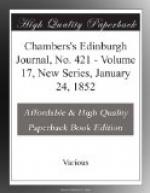The last time I saw Wenzel and Metski was in the trenches at Minsk, where they had a tough debate regarding our adventure in the forest: the woodman insisting it was the Finn’s spell that brought the wolves in such unheard-of numbers, and the peasant maintaining that it was a judgment on our desecration of Christmas-eve. For my own part, I think the long storm and a great scarcity of food had something to do with it, for tales of the kind were never wanting in our province. The wolf-gathering, however, saved us a journey to Siberia: thanks to old Wenzel. And sometimes yet, when any strange noise breaks in upon my sleep even here in England, I dream of being in his wild hut in the forest and listening to the wolfish voices at the door.
THE DROLLERIES OF FALSE POLITICAL ECONOMY.
Plans for paying the national debt.
It is not customary to associate the ludicrous with financial operations—with budgets, schemes of taxation, and national debts. In general, they are considered to assume a formidable aspect; and when that is not the case, their details are looked on as dry and uninteresting—they are universally voted a ‘bore.’ Yet we engage to shew, that there have been some financial projects which at the present day we can pronounce essentially ludicrous. And they are not the mere projects of enthusiasts and theoretic dreamers. They were put in practice on a large scale; they involved the disposal of millions of money; and they were in operation at so late a period, that the present generation paid heavy taxes for the purpose of carrying them out—taxes paid for nothing better than the success of a practical hoax.
The round hundreds of millions in which our national debt is set forth seem to have often confused the brains of our most practical arithmeticians and financiers. They seem to have felt as if these did not represent real money, but something ideal; or perhaps we might say, they have treated them like certain results of the operation of figures which might be neutralised by others, as the equivalents on the two sides of an equation exhaust each other. We never hear of a man trying to pay his own personal debts otherwise than with money, but we have had hundreds of projects for paying the national debt without money, and generally through some curious and ingenious arithmetical process. We might perhaps amuse our readers by an account of some of these, for to their absurdity there are no bounds; but we adhere in the meantime to our engagement, to shew that on this subject even the practical projects of statesmen of our own day have been ridiculous.




